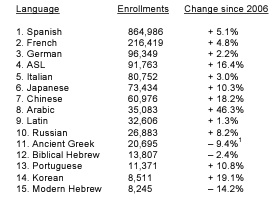Posted by Elena del Valle on January 13, 2011
Position filled
Title: Circana Network-Marketing Development Consultant
Blue Cross and Blue Shield of Florida
City Miami
State FL
Type Full Time
The position leads the development of the Circana network and builds ongoing strategic relationships with the Circana business partners in the U.S. and internationally.
Job duties include but are not limited to the following:
Click here for the full text of Circana Network-Marketing Development Consultant
Posted by Elena del Valle on January 12, 2011
Job Title: Communications Coordinator for Hispanic Media /Washington D.C.
Purpose:
Directs strategy and manages media relations for positioning SEIU members, campaigns and leaders in Hispanic media outlets. Builds relationships with International and local union communications staff and leaders to develop and coordinate public relations, media relations and general communications support for outreach to Hispanic media.
Click here for the full text of Communications Coordinator for Hispanic Media /Washington D.C.
Posted by Elena del Valle on January 12, 2011

Click to enlarge
While many consider 2010 an improvement over 2009 and some are optimistic about 2011 few can dispute the lingering effects of the recession on Americans. Although there are signs the economy is improving the number of unemployed nationally is alarming. And we are not alone. Beyond the United States the economic downturn has affected many countries which also exhibit sluggish growth and disappointing employment numbers, in many cases with far higher percentages than those in the United States.
According to a United Nations report (see Further sharp increases in global food prices ‘likely’, UN.org) the price of food is increasing around the globe. Recently an industry expert predicted that due to increasing demand and limited supply the price of gasoline may reach $5 per gallon as soon as 2012. Some point out that these are the normal ways in which artificially inflated economies right themselves, part of a normal cycle with highs and lows. In short, nothing to worry about in the long term.
Yet other data such as the increasingly alarming debt ratios of developed countries including the United States and many Western European countries (see Debt to growth ratios and their impact on business), and an abundance of developed countries with aging population demographics could signal that there is more to the situation that a cursory look might reveal.
If we step back and look at the changes over decades (see Income Inequality: Too Big to Ignore, The New York Times October 16, 2010) the picture that emerges is interesting. During the thirty years that followed World War II, the income of Americans grew 3 percent a year across income levels, fomenting a healthy middle class, well developed infrastructure and growing optimism.
In light of the recent economic downturn fewer voters are willing to support basic updates to infrastructure and public services leaving the country with troubled roads and bridges, a weak rail system, and poor safety standards such as cargo containers that enter our ports without scrutiny and dams in danger of collapsing.
During the past three decades economic growth has slowed, our infrastructure has fallen into disrepair and income growth is evident mostly among the highest percent of earners. For example, in 1976, the share of total income for the top 1 percent of earners was 8.9 percent; by 2007 it had reached 23.5 percent. During that same period the rest of the population’s average hourly wages, once adjusted for inflation, decreased by more than 7 percent. In summary, according to those statistics the ultra wealthy are becoming wealthier and everyone else is becoming less affluent.
Between 1983 and 2007 the most notable gains in wealth and income were among the most affluent 20 percent of the population, especially the top 1 percent, which received 35 percent of the total growth in net worth, 43 percent of the total growth in non home wealth and 44 percent of the total increase in income, according to Recent Trends in Household Wealth in the United States: Rising Debt and the Middle Class Squeeze – an Update to 2007 by Edward N. Wolff published by the Levy Institute of Bard College March 2010. According to the 58-page paper, in 2007, the top 1 percent of the population (those with net worth of $8.2 million or higher) in the country owned 49.3 percent of stocks and mutual funds, 60 percent of financial securities, and 62 percent of business equity. In contrast, the bottom 90 percent of the population owned 10.6 percent of the stocks and mutual funds, 1.5 percent of the financial securities, and 6.7 percent of the business equity.
An example of that are billionaires Warren Buffet and Bill Gates who have decided they are so exceedingly wealthy that they want to share their fortunes with humanity, making a commitment to distribute part of their wealth while they are alive. Recently they recruited other individuals to participate in the project, including Mark Zuckerberg the much talked founder of Facebook who although he is only 26 is wealthy enough to make the cut.
So what do these changes mean for businesses and business people? While only time will tell for sure in the short term it would appear that it is a good time to begin or continue marketing to the very wealthy; emphasizing products that represent good value for money to middle class and wealthy consumers and budget products to just about everyone except those at the very top of the income earners and asset holders.
Posted by Elena del Valle on January 10, 2011

The University of Florida College of Journalism and Communications’ Office of Communications is seeking applicants for a Director of Information/Publication Services. The Office of Communications is responsible for developing and coordinating a comprehensive, technology-rich, strategic communications plan for the College of Journalism and Communications, including the Division of Media Properties.
Click here for the full text of Director of Information/Publication Services
Posted by Elena del Valle on January 10, 2011



Arthur Levine, Ph.D, Juan Carlos Reyes and Laura Scheiber
Photos: Emile Wamsteker, Juan Carlos Reyes, Laura Scheiber
A podcast interview with Arthur Levine, Ph.D., president, The Woodrow Wilson National Fellowship Foundation, Juan Carlos Reyes, executive assistant to the president, Teachers College and Laura Scheiber, doctoral student in Comparative and International Education, Teachers College, Columbia University, is available in the Podcast Section of Hispanic Marketing & Public Relations, HispanicMPR.com. During the podcast, they discuss Levine and Scheiber’s recently published book (see Fellowship foundation leader, assistant examine challenges faced by South Bronx youth) with Elena del Valle, host of the HispanicMPR.com podcast.
Arthur is the sixth president of the Woodrow Wilson National Fellowship Foundation where he has been since 2006. Prior to that he was president and professor of education at Teachers College, Columbia University from 1994 to 2006. He also previously served as a faculty member and chair of the Institute for Educational Management at the Harvard Graduate School of Education. Arthur is co-author of Unequal Fortunes Snapshots from the South Bronx.
Juan Carlos Reyes is the executive assistant to the president at Teachers College. He, a student at Baruch College, has plans to graduate this year in Political Science. His next step will be working toward making a difference in the lives of children growing up in conditions similar to his childhood neighborhood.
Laura is a Fulbright grant recipient, her doctoral research focuses on innovative leaders of violence prevention and youth empowerment initiatives in Brazil. She earned a M.A. at Teachers College, specializing in international educational development and adult education, and a bachelors degree in psychology from Ohio University. A former anchor for AfterED news, she has also taught college-level courses on child development.
To listen to the interview, scroll down until you see “Podcast” on the right hand side, then select “HMPR Arthur Levine, Ph.D., Juan Carlos Reyes, Laura Scheiber” click on the play button below or download the MP3 file to your iPod or MP3 player to listen on the go, in your car or at home. To download it, click on the arrow of the recording you wish to copy and save it to disk. The podcast will remain listed in the January 2011 section of the podcast archive.
Posted by Elena del Valle on January 7, 2011

What does the future hold for Cuba now that its famous leader has taken a back seat? Energy resources that allow the Caribbean island nation to improve its economy may be increasingly important in the future and may affect the United States. This is the belief of Jonathan Benjamin-Alvarado, a professor of political science at the University of Nebraska Omaha, and editor of Cuba’s Energy Future Strategic Approaches to Cooperation (Brookings Institution Press, $26.95), a recently published book.
In addition to Benjamin-Alvarado, Jorge Piñon, senior research fellow at Florida International University; Juan A.B. Belt, director of Chemonics International; Amy Myers Jaffe, Wallace S.Wilson Fellow in Energy Studies, Rice University; and Ronald Soligo, Rice scholar, Rice University contributed to the 143-page softcover book.
Benjamin-Alvarado is assistant director of the Office of Latino/Latin American Studies. He is also senior research associate of the Center for International Trade and Security at the University of Georgia. He is the author of Power to the People: Energy and the Cuban Nuclear Program.

Click to buy Cuba’s Energy Future
Comments:
Filed Under: Books
Posted by Elena del Valle on January 5, 2011

U.S. student enrollment by language 2006-2009 per MLA report
Graphic: Modern Language Association of America
Interest in foreign languages in colleges in the United States increased 6.6 percent between 2006 and 2009. Foreign language enrollment has also been increasingly diverse including a broad range of language studies, according to a new report, Enrollments in Languages Other Than English in United States Institutions of Higher Education, Fall 2009, released December 2010 by the Modern Language Association of America (MLA).
Arabic popularity rose as did Korean and Chinese. Although French, German and Italian were popular Spanish was the most popular foreign language by a wide margin with 864,986 students enrolling in classes during the time period of the report.
“It’s gratifying to see that so many US students recognize the importance of language study for our future,” said Rosemary G. Feal, executive director, Modern Language Association of America in a press release. “The demand for an ever-greater range of languages demonstrates the vitality of the field. Despite troubling cutbacks in language offerings at some institutions, this report shows that overall language remains strong at US colleges and universities.”
The MLA report, produced since 1958, is described as the longest-running and most comprehensive analysis of the study of languages other than English at United States colleges and universities. The report includes undergraduate and graduate course enrollments in languages other than English in fall 2009 for 2,514 AA-, BA-, MA-, and PhD-granting colleges and universities in the United States. The researchers believe these 2,514 institutions represent 99 percent of all higher education institutions offering language courses in the country.
The Modern Language Association of America, dedicated to strengthening the study and teaching of languages and literature, has 30,000 members in 100 countries. Founded in 1883, the MLA strives to provide opportunities for its members to share their scholarly findings and teaching experiences with colleagues and to discuss trends in the academy. According to the MLA website the organization produces twelve new books a year and a variety of publications for language and literature professionals and for the public.
Posted by Elena del Valle on January 3, 2011

We wish you and yours a wonderful, healthy and prosperous 2011!



















